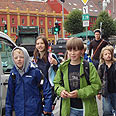
For far too long, the debate about Scandinavian anti-Semitism in the Israeli English-language media has been hijacked by extremists. Last week, Dr. Manfred Gerstenfeld again depicted Norway as a Jew-hating hub, overflowing with anti-Semitic media and politicians.
Anti-Semitism is a cancer that Europe can't seem to completely get rid of, despite education systems highlighting tolerance and lessons from history. To be sure, raising awareness and engaging in a serious debate on Norwegian anti-Semitism is crucial and most welcome. However, Gerstenfeld and his peers paint a false and exaggerated picture in their promotion of Norway as a major purveyor of anti-Semitism. Such discourse does not only describe reality inaccurately, but is also counter-productive and damaging to serious efforts in fighting anti-Semitism.
Applying history selectively
The study shows that Norway has hard work ahead in combating such attitudes. However, it also reveals that the level of anti-Semitism in Norway is on par with other Western European states. The survey describes a complicated picture where 11% felt antipathy towards Jews, while 27% felt a special sympathy for them. Also, Norwegians are more prejudiced to other minorities. While the population preferred to be friends with Americans, Catholics and Jews, they were most negative toward interaction with Muslims, Somalis and people of Roma background.
A study conducted by the Anti-Defamation League on European anti-Semitism supports these findings by placing Norway between Holland and the UK. Gerstenfeld's assessment that 1.5 million out of 5 million Norwegians are anti-Semitic, seems at best unserious for anyone familiar with the country, and is based on a simplistic reading of an intricate study. If 38% of the population is anti-Semitic, why do 92% believe it is important to teach children about the Shoah?
Gerstenfeld and likeminded scholars also apply history selectively, and mention only events that strengthen their argument. Typically, the late admission of Jews into Norway or the anti-Israeli riots in Oslo during Operation Cast Lead are cited. While these incidents indeed taint Norwegian history, other events are conveniently overlooked, like the close political and grassroots relationship between Norway and Israel during the Ben-Gurion era, or early collaboration between the Norwegian Labor Union and the Histadrut.
Reality isn’t black and white
In addition, hard-line critics seem to be unaware of the complexities of the current debate in the country. Norwegian anti-Semitism has been the focus of all major media outlets, and coverage of the Israeli-Palestinian conflict has, according to the leader of the Jewish community, improved over the last years. Because most of the discourse is not available in English, much of it may not be picked up by foreign commentators. That can explain why Gerstenfeld falsely labels the Norwegian prime minister as a part-time anti-Semite.
Gerstenfeld describes Norwegian media and political elite as unbalanced, anti-Israeli and anti-Semitic. Indeed, the many layers of the Israeli-Palestinian conflict are at times overlooked in newspapers, and commentators now and then make judgments based on shallow knowledge of the Middle East. However, Gerstenfeld falls into the same trap himself. Without an adequate understanding of Norwegian culture and context, he time and again engages in black and white analysis and conclusions. Ervin Kohn, the leader of the Jewish community in Norway, previously described Gerstenfeld’s allegations as untrue, and accused him of painting an unbalanced picture of the situation of Jews in the country.
Unfortunately, Gerstenfeld and his ilk are the main voices being heard in the debate on anti-Semitism in Scandinavia. Their conduct does not only distort reality, but damages the efforts of serious actors in their fight against anti-Semitism. Outcries of anti-Jewish attitudes should never be used without sufficient ground, as to not undermine real claims of anti-Semitism. During my stay in Israel, I have learned that reality is very far from black and white. This lesson applies everywhere.
Kristina Furnes is a Norwegian student of Government, Diplomacy and Strategy at the Interdisciplinary Center in Herzliya















